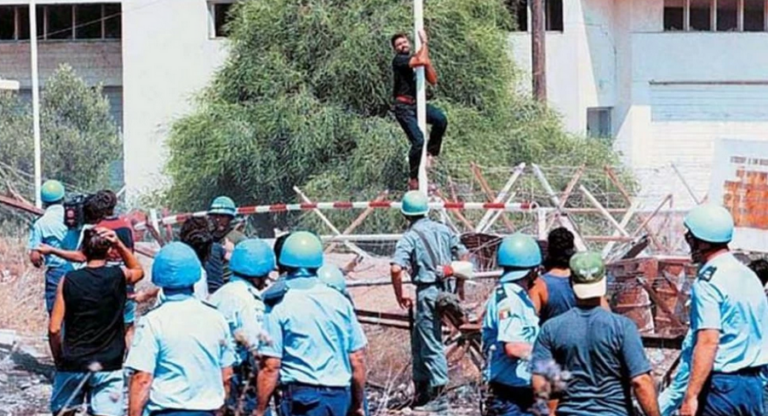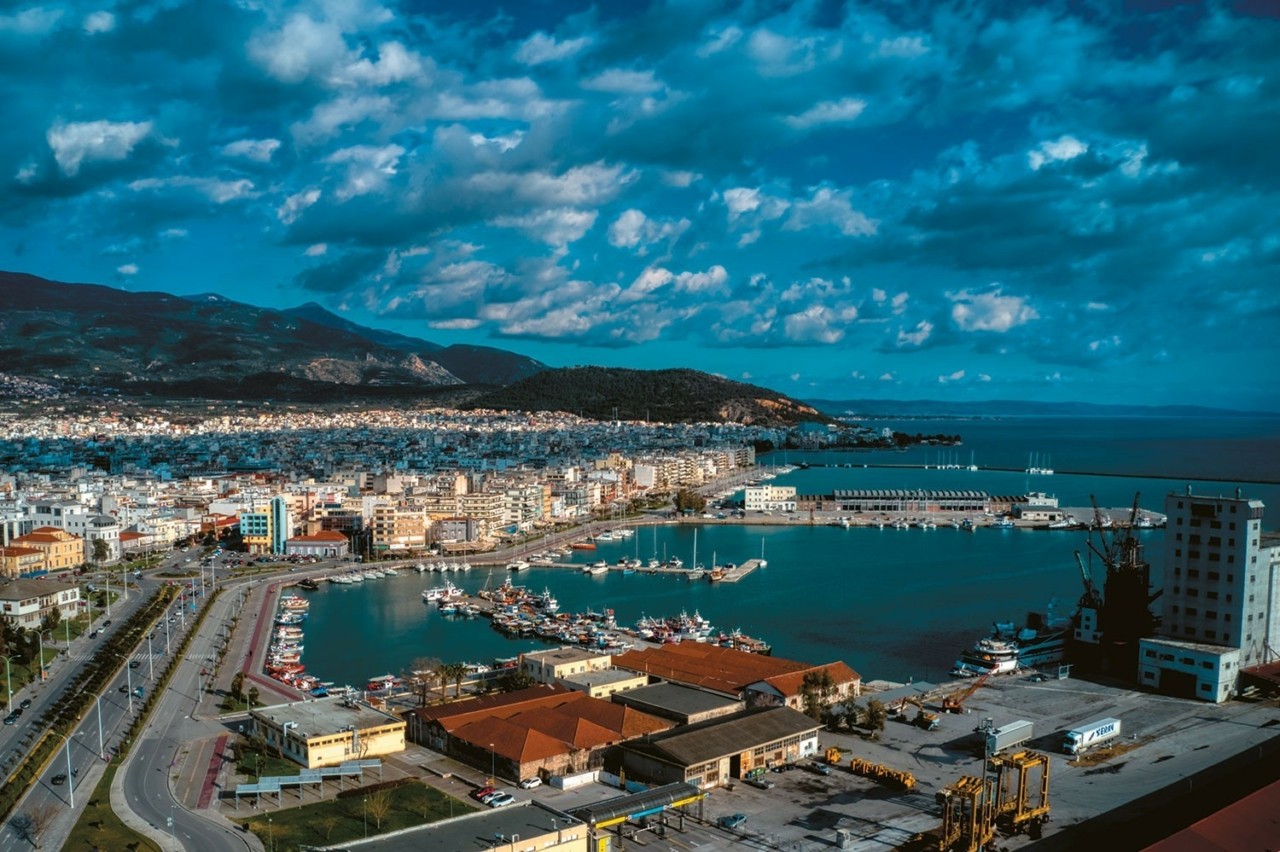Twenty-seven years ago, this month, two brave Greek Cypriots, Tassos Isaak, 24, and Solomos Solomou, 26, who wanted their country free from illegal occupiers, were brutally killed by Turkish occupation forces.
Isaak was beaten to death on August 11, 1996 by a Turkish mob while taking part in an anti-occupation demonstration in a UN-controlled buffer zone. Three days later, his cousin, Solomou, was killed after being shot five times by Turks. The international community should remember and honor their memories.
How the Murders Occurred
Turkey invaded the Republic of Cyprus in the summer of 1974, divided it into two regions through an ethnic cleansing campaign and established an illegal regime on the 36 percent of the island country’s land.
In August of 1996, with the participation of over 200 bikers from several European countries, the Cyprus Motorcycle Federation (CMF) organized a rally to the Cypriot city of Kyrenia to protest the Turkish occupation of northern Cyprus. The rally took place at several points along the United Nations buffer zone east of Nicosia, the divided capital of the Republic of Cyprus. Around 35 % of Nicosia is illegally occupied by Turkey.
The authorities of the “Turkish Republic of Northern Cyprus” (TRNC), which ostensibly controls the land occupied by Turkish troops, announced that they would organize “counter-rallies” with the participation of the Turkish fascist Grey Wolves group. Heavy political pressure – including by United Nations Secretary-General Boutros Boutros-Ghali – was applied on the Cyprus Motorcycle Federation, resulting in the cancelation of the event. Afterward, many bikers and other protesters (among them Anastasios Tassos Isaak) decided to march on their own in a peaceful demonstration against Turkey’s military occupation. They then entered the United Nations Buffer Zone near Deryneia, south of the city of Famagusta.
The Hellenic Resources Network reported:
The bikers, who began their journey in Berlin, were protesting the fact that Cyprus remains Europe’s only divided country. They and their message were welcomed when they arrived in Cyprus.
Determined to ride into the occupied territory in the name of freedom of movement, they met a military response: 24-year-old Tassos Isaac from Paralimni, Cyprus, was murdered by Turks who rained blows down on him as he struggled to free himself from barbed wire in the neutral zone in Deryneia separating free from occupied Cyprus.
As United Nations peacekeepers stood by, Isaac was beaten with clubs [and] pelted with stones for 15 minutes. Only after Greek-Cypriots managed to get him away from his assailants did U.N. forces intervene to stop the mob.
Cypriot president Glavcos Clirides expressed his sorrow over the death of Isaac. International tolerance of the Turkish occupation, he said, encourages the Turks in their brazen brutality.
When Isaak was murdered, he left behind his pregnant wife. His daughter, Anastasia, a member of the Isaak-Solomou Memorial Initiative, has been struggling to find justice since her father’s murder.
On August 14, Isaak’s cousin, Solomou, also became a victim of the violence of the Turkish occupation forces.
On that day, a group of unarmed Greek Cypriots reentered the area where Isaak was murdered to demonstrate. Solomou was one of them and began to climb a flagpole flying a Turkish flag – but was shot dead by Turks.
The incident was taped by nearby journalists and was broadcasted live on Greek and Cypriot television, with millions of people watching the murder live on their screens. A video of the killing is available here (graphic content).
The families of Isaak and Solomou took the murders to the European Court of Human Rights in the cases of Isaak v. Turkey (application no. 44587/98) and Solomou v. Turkey (application no. 36832/97).
In the application file of Isaak’s family to the Court, the deadly incident is described as follows:
During that demonstration Anastasios Isaak was kicked and beaten to death by Turkish and Turkish-Cypriot policemen and counter-demonstrators. A group of about 15-20 people surrounded Mr Isaak and threw him to the ground. He was then repeatedly kicked and beaten with metal and wooden batons. There were allegedly eight “TRNC” police officers in the vicinity. When a police officer from the UN Forces in Cyprus (UNFICYP) tried to intervene and started pushing some of the attackers away, Mr Isaak was already unconscious.
A post-mortem report concluded that the cause of Mr Isaak’s death was ‘multiple head trauma’.
The applicants submitted several witness statements from UNFICYP officers and the Cyprus Police. The members of UNFICYP unanimously declared that Mr Isaak had been attacked and beaten to death by a group of counter-demonstrators and that some members of the ‘TRNC’ police had either watched the scene passively or had participated in the beating.
The applicants also submitted 37 photographs and a video recording by Reuters. Those images showed a group of people, armed with sticks, attacking Mr Isaak, who was lying on the ground. The group beat him for several minutes. At least four uniformed soldiers belonging to the Turkish or Turkish-Cypriot forces were seen in the vicinity of the incident and participating in the mob. The recording also showed a UN officer intervening with the aid of two policemen, pushing back the crowd who had surrounded Mr Isaak.
Solomou’s family members also described the deadly attack in their application:
Solomos Solomou crossed the barbed wire at the Turkish ceasefire line and entered the occupied territory. He was pursued by a British soldier from UNFICYP, who attempted to pull him back.
Solomou broke free from the British soldier and attempted to climb the pole where the Turkish flag was flying. He was unarmed, was not acting in a manner which could have been considered threatening and was smoking a cigarette.
While he was approximately three meters up the pole, he was hit by five shots fired by at least three persons from the Turkish side, and was fatally injured. He died almost instantly. The Turkish forces then opened fire in an indiscriminate manner, wounding two members of UNFICYP, a civilian in the buffer zone and a civilian who was standing behind the Cypriot Government’s ceasefire line.
August 15: Assumption of Virgin Mary & Greek customs (photos)
In 2008, the European Court of Human Rights found Turkey guilty of violating Isaak’s and Solomou’s right to life and of failing to conduct an effective investigation into the circumstances in which they were killed.
The court also concluded that Isaak and Solomou “had been killed by agents of the Turkish State and that the use of force had not been justified, in violation of Article 2” (right to life).
Twenty-six years following the murders, Turkey is yet to implement the requirements of the judgement of the ECHR.
In 2021, the Council of Europe’s Committee of Ministers called on Turkey to provide by year’s end additional information concerning the killings of four Greek Cypriots including Isaak and Solomou. “The Committee supervises the implementation of judgments by the European Court of Human Rights,” The Cyprus Mail then reported. “In its decision, it also said it will resume examination of these cases in June 2022 at the latest.”
Meanwhile, the Cypriot newspaper Phileleftheros has published the names of the persons wanted for the murders of Isaak and Solomou, adding:
The perpetrators are not only living their lives undisturbed but are even active in politics in the occupied territories. Although national and international arrest warrants have been issued for those involved in the brutal killings on 11 and 14 August 1996, so far none of them has been executed. In fact, one of the murderers, Erhan Arıklı, recently ran for president in the illegal ‘presidential’ elections of the occupied territories.
The 1974 Invasion
Solomou was born in 1970 in the Cypriot city of Famagusta, occupied by Turkey since 1974. His family had lost their home and land, which fell under the control of the Turkish occupation forces. They were forced to leave their hometown behind and fled to the nearby town of Paralimni as internally displaced persons.
The Turkish army invaded Famagusta and the rest of northern Cyprus in two separate campaigns – on July 20 and August 14 – in 1974, committing many crimes. The aim of the Turkish army was to terrorize Greek Cypriots and to sweep them southward.
“On Augusta 14,” wrote author Victoria Hislop, “the Greek Cypriot population fled in terror, in cars, on buses, by foot, taking nothing but the clothes they stood up in. They expected help from a foreign power, but none came, and their evacuation turned into weeks, then months, then decades.”
As was the case with tens of thousands of other Cypriots, the life of Maria Hadjivasili, who grew up in Famagusta, also changed completely after the occupation of her town.
“We heard that civilians had been killed and women raped,” she said. “People were anxious for their daughters. I heard that one of my school friends was raped and killed.”
As a result of the Turkish invasion and subsequent occupation of the northern part of Cyprus, around 170,000 Greek Cypriots were forced to flee from their homes and are still unable to return due to the ongoing occupation.
What is even more tragic is the fact that, during the period of the Turkish invasion, world opinion did not raise much of an outcry. And since there still is no international outrage, the occupation continues − accompanied by illegal seizures of Greek Cypriot properties and lands and the destruction of Greek and other non-Muslim cultural heritage.
Cyprus, which has been Hellenic and Christian for millennia, has been illegally occupied, ethnically cleansed, and colonized at the hands of Turkey for the past 48 years.
The civilized world owes Isaak, Solomou and other Greek Cypriots a reunited Cyprus free from occupying troops and imported settlers, and a genuine apology for leaving them alone in the face of a tyrannical invading force.
Source: Providence
Ask me anything
Explore related questions





